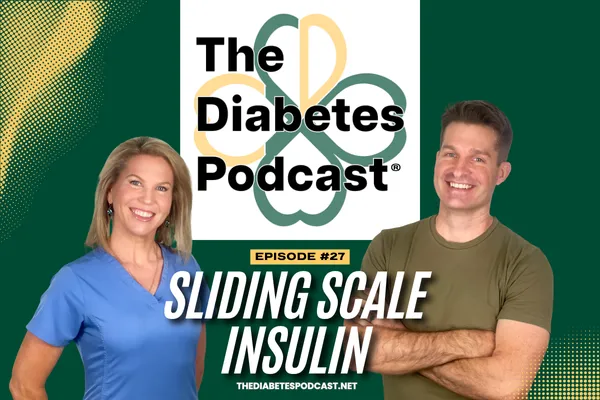
EP027 - Sliding Scale Insulin and Type 2 Diabetes
Insulin Sliding Scale: Why It Feels Like You’re Chasing Sugar (And What To Do Instead)
“Sliding scales are reactive—safe-ish, but they keep you chasing your sugar.”
If insulin sliding scale has you feeling like you’re always chasing your sugar, you’re not alone. It’s common. It’s frustrating. And there’s a better way.
In this episode of The Diabetes Podcast, we broke down why sliding scale insulin often fails, how insulin really works in your body, and simple steps you can take to feel steady and in control.
What sliding scale insulin is (and why it feels reactive)
What it is: A chart that says “If your blood sugar is X, take Y units.”
What it does: Covers the sugar that’s already in your blood right now.
What it misses: The food you’re about to eat.
What happens: You take insulin “by the number,” then you eat carbs, and your sugar rises anyway. You end up playing catch-up all day and night.
The big idea: sliding scale insulin treats the past. It’s reactive. To get ahead, you need a proactive plan.
Basal vs. bolus: the two jobs of insulin
Think of insulin in two parts, each with a job.
Basal insulin (background, basic, “B-A” for basal):
Long-acting insulin that releases slowly over about 24 hours.
Keeps blood sugar steady between meals and overnight.
Goal: steady fasting glucose. Not for meals.
Bolus insulin (bonus/mealtime, “B-O” for bolus):
Rapid-acting insulin you take for food and to correct highs.
Covers carbs you eat and brings down highs.
Goal: match food and fix spikes.
In a healthy pancreas, your body does both all day long. When you take insulin by injection, you’re trying to copy that pattern.
Timing is everything
Carbs start raising blood sugar in about 10 minutes.
Most rapid-acting insulin doesn’t start working for ~15–20 minutes.
If you inject at the first bite (or after), insulin is late. You spike fast.
Try this: take bolus insulin 15–20 minutes before your first bite. Then check 2 hours after the meal. Most people see smoother lines and feel steadier.
What is a correction factor?
Also called insulin sensitivity factor.
It tells you how much 1 unit of insulin lowers your blood sugar.
Example: If your factor is 40, 1 unit lowers your blood sugar about 40 points.
Why it matters: sliding scales often don’t match your true sensitivity, so you can get too little (still high) or too much (go low).
Over basalization: the hidden problem keeping A1C high
This happens when your long-acting (basal) dose keeps going up, even though your fasting sugar looks good.
Clue: fasting numbers are fine (100–115), but A1C stays high (like 8.5%).
Why: you’re using basal to cover mealtime spikes. Basal isn’t for meals.
Fix: stop increasing basal. Add mealtime bolus insulin for the carbs you eat. Sometimes you even reduce basal to make room for bolus.
A safer, smarter plan than pure sliding scale
Move from reactive to proactive. Here’s how:
Keep basal for fasting only.
Goal: steady overnights and between meals.
If you drop a lot overnight (for example 300 down to 100), you may be on too much basal. Talk with your provider.
Add a mealtime bolus for carbs.
Best practice: prebolus 15–20 minutes before eating.
If counting carbs is hard, consider a set dose plan:
Rough idea: about half your total daily insulin as basal, and the other half split across meals.
Example: Total 50 units/day → 25 units basal + ~8 units at each meal (adjust with your provider).
Use correction doses thoughtfully.
Base them on your personal correction factor, not a generic chart.
Pair insulin with simple movement.
A short walk (2–10 minutes) after meals helps muscles soak up sugar fast.
This lowers spikes and may reduce how much bolus you need over time.
Real-life timing challenges (and what to do)
Eating out? Order first, inject in time, or choose ultra-fast insulin if you always dose at the table.
Not sure what you’ll eat? Take a partial prebolus, then finish dosing when food arrives.
Forget to prebolus? A short post-meal walk can help take the edge off the spike.
When to talk to your provider about changes
Your fasting is good, but your A1C stays high.
You “feed your insulin” (you must eat to avoid lows).
You drop a lot overnight or between meals.
You’re using sliding scale only, but still spike after eating.
You’re starting lifestyle changes (more walking, more veggies) and notice more lows.
Important safety note
Insulin is a prescription medicine. Don’t change your dose on your own. Use this information to have a clear conversation with your doctor or diabetes team. If you have type 1 diabetes, take special care: sliding scales meant for type 2 can overdose you.
Practical tips you can try this week
If you already use mealtime insulin: take it 15–20 minutes before eating for 7 days. Check 2 hours after meals. Watch how much steadier you feel.
If you’re on basal only or sliding scale only: ask your provider if adding a small mealtime dose at your highest-carb meal could help.
Walk after meals: even 2–5 minutes helps. Aim for 10–15 minutes when you can.
Notice patterns: Do you crash at night? Do you spike only after certain foods? Write it down or tag it in your CGM.
What about starting insulin in type 2?
Many people start insulin later than they should. Early, gentle insulin can protect your beta cells and may help long-term outcomes.
Start slow. Titrate slowly with your provider. Learn timing. Build confidence.
If you ever can’t get your insulin
In a pinch, Walmart sells Humulin R or Novolin R over the counter for about $35. If you rely on insulin (like with type 1), this can be life-saving. Ask the pharmacist and call your provider as soon as possible for support.
Bottom line
Sliding scale insulin is reactive and often keeps you chasing highs.
A proactive plan uses:
Basal for fasting.
Bolus for meals and corrections.
Smart timing (prebolus).
Simple movement after meals.
Small shifts in timing and dosing strategy can change your day—and your A1C.
Take courage! You can do this, and we can help. If you have questions, send them to [email protected] and we may feature them in a future episode.
References used in this podcast:
Disclaimer
The information in this blog post and podcast is for educational and informational purposes only. It is not medical advice, diagnosis, or treatment, and it does not replace a one-on-one relationship with your physician or qualified healthcare professional. Always talk with your doctor, pharmacist, or care team before starting, stopping, or changing any medication, supplement, exercise plan, or nutrition plan—especially if you have diabetes, prediabetes, heart, liver, or kidney conditions, or take prescription drugs like metformin or insulin.
Results vary from person to person. Examples, statistics, or studies are shared to educate, not to promise outcomes. Any discussion of medications, dosing, or side effects is general in nature and may not be appropriate for your specific situation. Do not ignore professional medical advice or delay seeking it because of something you read or heard here. If you think you are experiencing an emergency or severe side effects (such as persistent vomiting, severe diarrhea, signs of dehydration, allergic reaction, or symptoms of lactic acidosis), call your local emergency number or seek urgent care right away.
We strive for accuracy, but health information changes over time. We make no guarantees regarding completeness, timeliness, or suitability of the content and assume no liability for actions taken or not taken based on this material. Use of this content is at your own risk.
Links or references to third-party resources are provided for convenience and do not constitute endorsement. By reading, listening, or using this information, you agree to these terms and understand that you are responsible for your own health decisions in partnership with your licensed healthcare provider.

